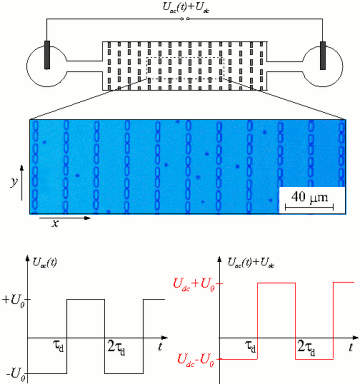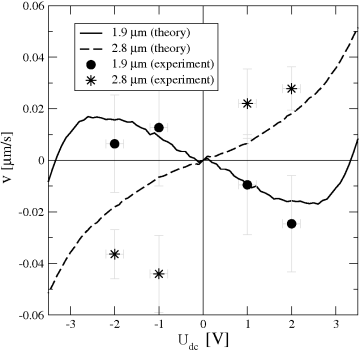
|

|
| Participating group members: | Peter Reimann, Sebastian Getfert, Marc Fliedner |
| Main cooperation partners: | Dario Anselmetti, Jan Regtmeier, Lukas Bogunovic
(Biophysics and applied Nanoscience group at Bielefeld University
Ralf Eichhorn, NORDITA (Stockholm) |

|

|
A typical example of such a new migration mechanism is a Brownian particle, diffusing in a suitably designed geometrical structure. Though far from equilibrium, its linear response to an external static force is a current, exactly as if it were at equilibrium. However, in the non-linear response regime, the particle slows down and then even starts to move in the direction opposite to the applied force. Typically, the stopping force at which this change of the migration direction occurs depends on particle properties like size or shape, opening new possibilities for the application in the separation of biomolecules.
Other examples are the selective acceleration of effective diffusion coefficients, ratchet effects, noise-induced collective phenomena far from equilibrium, and migration phenomena of driven polymers. Besides unraveling further new phenomena along these lines, our main emphasis is on specific experimental realizations of the predicted effects.
Typically we proceed along the following three steps:
(i) Theoretical identification and development of new transport concepts
and principles (qualitatively).
(ii) Their quantitative modelling and optimization
within the given experimental possibilities.
(iii) Their experimental realization by means of suitably structured
microfluidic devices and selected biomolecules.
Selected publications on negative mobility
(motion opposite to an applied force):
R. Eichhorn, P. Reimann, and P. Hänggi
Brownian Motion exhibiting Absolute Negative Mobility
Phys. Rev. Lett. 88, 190601 (2002)
R. Eichhorn and P. Reimann
Paradoxical non-linear response of a Brownian particle
Phys. Rev. E, 70, 035106(R) (2004)
R. Eichhorn and P. Reimann
Paradoxical directed diffusion due to temperature anisotropies
Europhys. Lett. 69, 517 (2005)
A. Ros, R. Eichhorn, J. Regtmeier, T. T. Duong,
P. Reimann, and D. Anselmetti
Absolute negative particle mobility
Nature 436, 928 (2005)
J. Regtmeier, R. Eichhorn, T. T. Duong, P. Reimann, D. Anselmetti, and A. Ros
Pulsed-field separation of particles in a microfluidic device
Eur. Phys. J. E 22, 335 (2007)
J. Regtmeier, S. Grauwin, R. Eichhorn, P. Reimann, D. Anselmetti, and A. Ros
Acceleration of absolute negative mobility
J. Sep. Sci. 30, 1461 (2007)
J. Nagel, D. Speer, T. Gaber, A. Sterck, R. Eichhorn, P. Reimann, K. Ilin, M. Siegel, D. Koelle, and R. Kleiner
Observation of Negative Absolute Resistance in a Josephson Junction
Phys. Rev. Lett. 100, 217001 (2008)
R. Eichhorn, J. Regtmeier, D. Anselmetti, and P. Reimann
Negative mobility and sorting of colloidal particles
Soft Matter 6, 1858 (2010)
Selected publications on the
acceleration and control of diffusion:
M. Schreier, P. Reimann, P. Hänggi, and E. Pollak
Giant Enhancement of Diffusion and Particle Separation in Rocked
Periodic Potentials
Europhys. Lett. 44, 416 (1998)
P. Reimann, C. Van den Broeck, H. Linke, P. Hänggi, J.M. Rubi, and A. Perez-Madrid
Giant Acceleration of Free Diffusion by use of Tilted Periodic Potentials
Phys. Rev. Lett. 87, 010602 (2001)
D. Reguera, P. Reimann, P. Hänggi, and J.M. Rubi
Interplay of Frequency-synchronization with Noise: Current Resonances, giant Diffusion and Diffusion-crests
Europhys. Lett. 57, 644 (2002)
D. Reguera G. Schmid, P. S. Burada, J. M. Rubi
P. Reimann, and P. Hänggi,
Entropic Transport: Kinetics, Scaling, and Control Mechanisms
Phys. Rev. Lett. 96, 130603 (2006)
M. Evstigneev, O. Zvyagolskaya, S. Bleil, R. Eichhorn, C. Bechinger, and P. Reimann
Diffusion of colloidal particles in a tilted periodic potential: Theory versus experiment
Phys. Rev. E 77, 041107 (2008)
P. Reimann and R. Eichhorn
Weak Disorder Strongly Improves the Selective Enhancement of Diffusion in a Tilted Periodic Potential
Phys. Rev. Lett. 101, 180601 (2008)
D. Speer, R. Eichhorn, and P. Reimann
Anisotropic diffusion in square lattice potentials: giant enhancement and control
EPL 97, 60004 (2012)
Selected publications on further new migration concepts:
D. Speer, R. Eichhorn, and P. Reimann
Directing Brownian Motion on a Periodic Surface
Phys. Rev. Lett. 102, 124101 (2009)
D. Speer, R. Eichhorn, and P. Reimann
Exploiting Lattice Potentials for Sorting Chiral Particles
Phys. Rev. Lett. 105, 090602 (2010)
P. Tierno, P. Reimann, T.H. Johansen, and F. Sagues
Giant Transversal Particle Diffusion in a Longitudinal Magnetic Ratchet
Phys. Rev. Lett. 105, 230602 (2010),
Physical Review Focus
L. Bogunovic, R. Eichhorn, J. Regtmeier, D. Anselmetti, and P. Reimann
Particle sorting by a structured microfluidic ratchet device with tunable selectivity: theory and experiment
Soft Matter 8, 3900 (2012)
New subject: Translocation of DNA through nanopores
A. Spiering, S. Getfert, A. Sischka, P. Reimann, and D. Anselmetti
Nanopore Translocation Dynamics of a Single DNA-Bound Protein
Nano Lett. 11, 2978 (2011)
Last modified on 2012-03-14